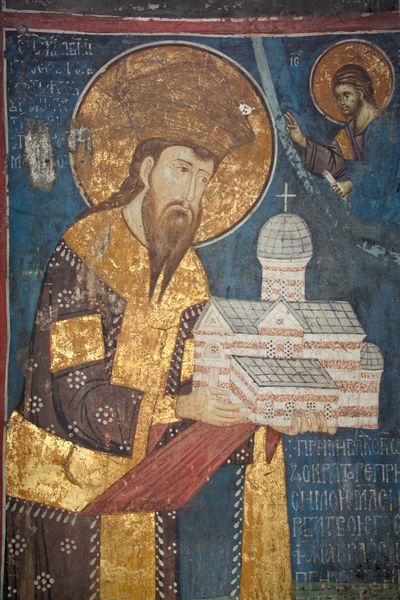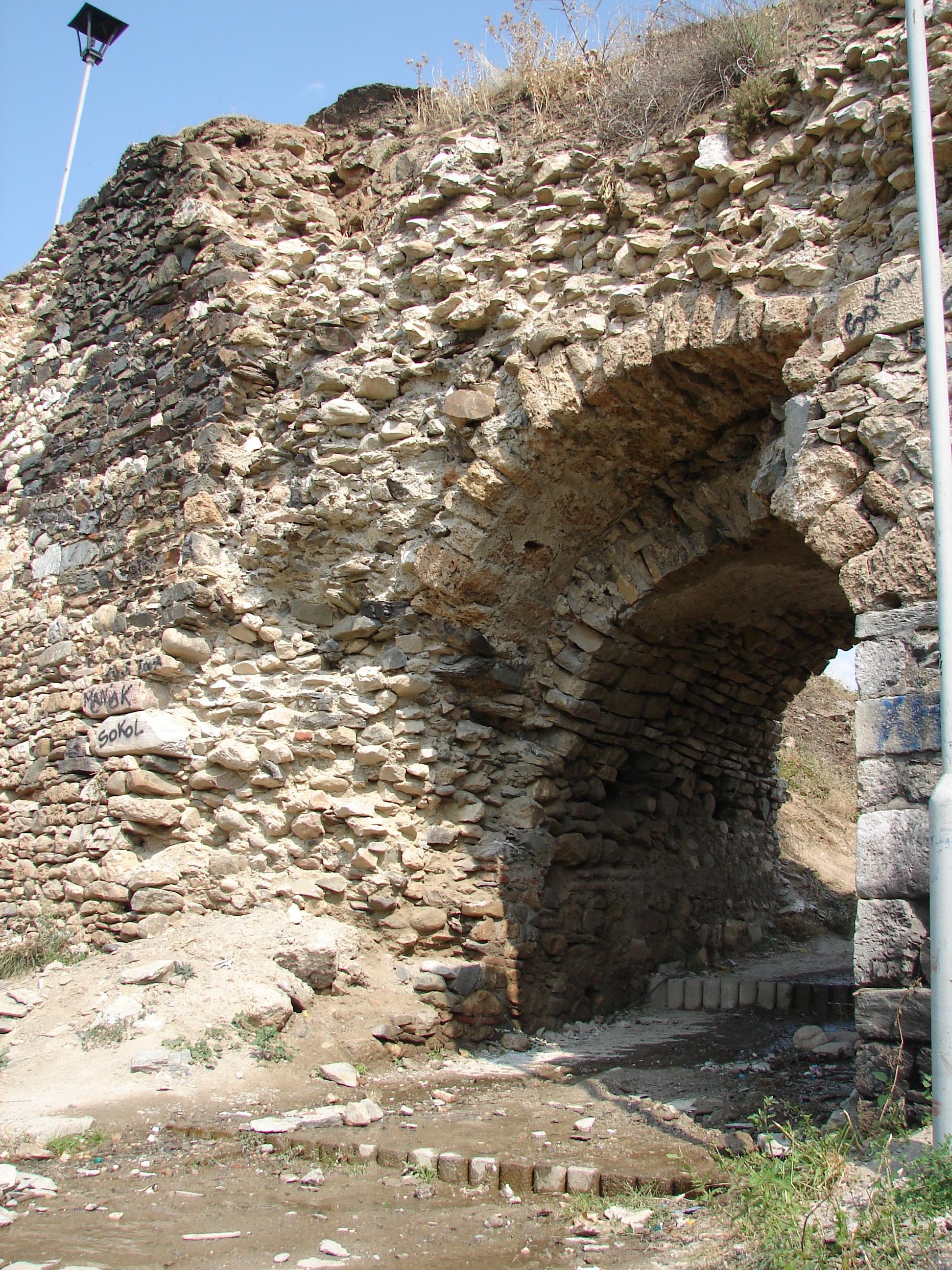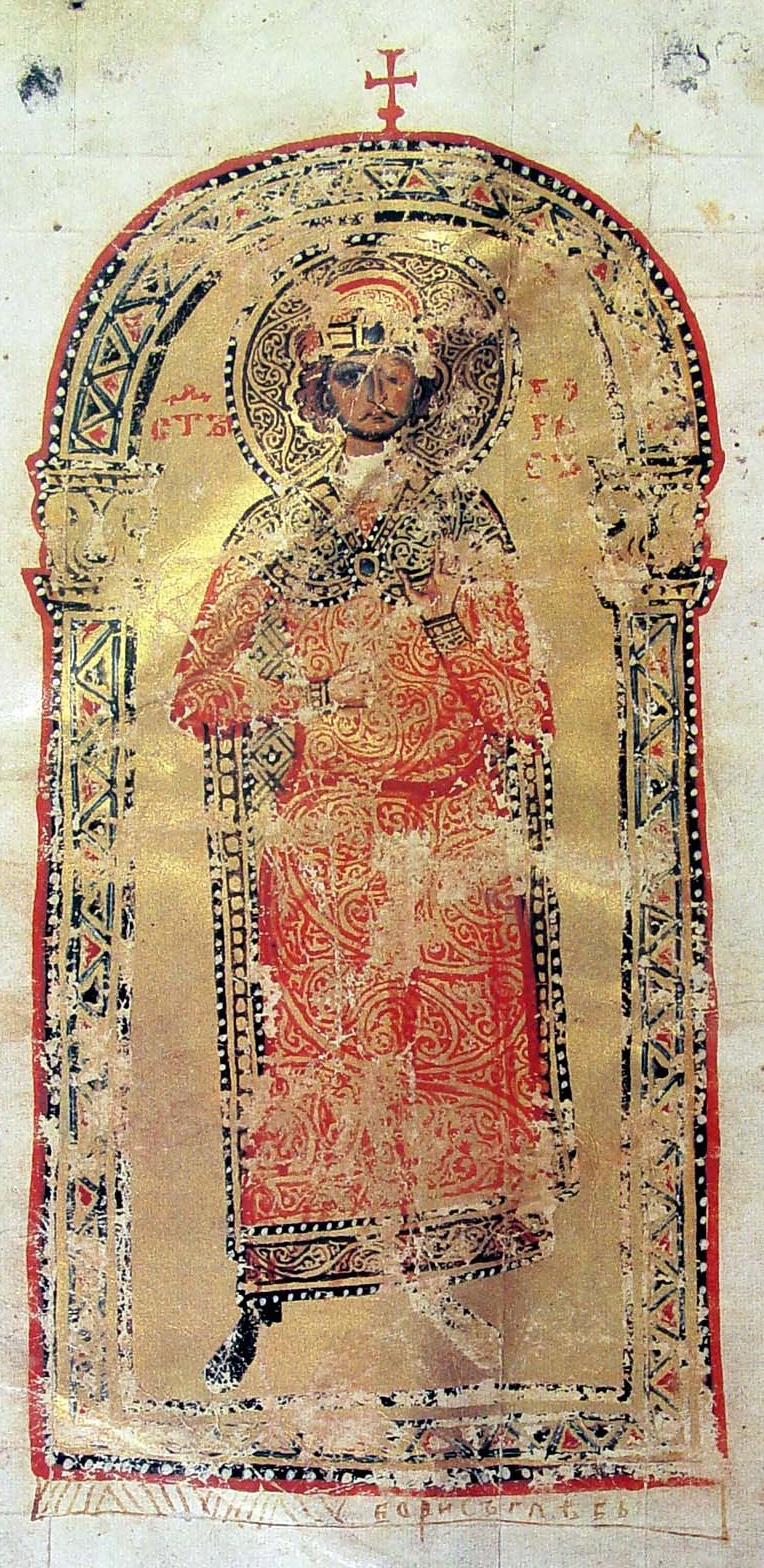|
Paskač
Paskač (; 1365) was a Serbian nobleman that served the Serbian Empire, with the title of '' knez''. Together with his son, ''sevastokrator'' Vlatko, he founded the Psača Monastery, in which the ''ktetor'' fresco of his family (of three generations) has been preserved, painted between 1365 and 1371. He is depicted as an old man, grey-haired, holding the church model together with Vlatko in the centre. By Paskač is his wife, noblewoman Ozra, and also their grandson, Uglješa. The family is wearing rich clothing. Nothing else is known of Paskač; he is not mentioned in donation charters. His function in the state is unknown, and it is unknown in which capacity he received the title of ''knez''. Mandić theorizes that if Paskač was a magnate, he would have succeeded Vojislav Vojislav ( sr-Cyrl, Војислав, ) is a Serbian masculine given name, a Slavic dithematic name (of two lexemes), derived from the Slavic words ''voj'' ("war, warrior"), and ''slava'' ("glory, fame"). ... [...More Info...] [...Related Items...] OR: [Wikipedia] [Google] [Baidu] |
Paskačić Noble Family
The Paskačić family (Serbian Cyrillic: Паскачић, Paskačići / Паскачићи) was a Serbian noble family that served the Serbian Empire, of Dušan the Mighty (r. 1331-1355) and Uroš the Weak (r. 1355-1371), then the Mrnjavčević family' as Lords of Prilep (1371–1395) during the ''Fall of the Serbian Empire''. History The eponymous founder was ''kefalija'' Paskač, and the family base was in Slavište (modern North Macedonia) and they held the modern border region between Serbia and the latter. Paskač had a son, Vlatko Paskačić, (hence, the family is also known as Vlatković (Serbian Cyrillic: Влатковић, Vlatkovići / Влатковићи)) who received the title of ''sevastokrator'' in 1365, when Vukašin Mrnjavčević was declared co-ruler as ''King of Serbs and Greeks''. Family *''knez'' Paskač, married Ozra **''sevastokrator'' Vlatko, married Vladislava *** Stefan ***''kesar'' Uglješa (fl. 1371 - after 1427) ****Stefan (d. ca. 1400) *** ... [...More Info...] [...Related Items...] OR: [Wikipedia] [Google] [Baidu] |
Vlatko Paskačić
Vlatko Paskačić () was a 14th-century Serbian feudal lord (''sebastokrator'') of Slavište region around Kriva Palanka under the Mrnjavčevići (1366-1395), in modern North Macedonia. His father was Paskač, a noble during the time of Stefan Dušan, his mother was Ozra. He ruled the ''Slavište župa'' stretching from Vranje in Serbia to Kriva Palanka in Macedonia. He and his father founded the Orthodox Christian Psača Monastery and donated it to Mount Athos. He held the office of late Dejan Dragaš Dejan ( sr-Cyrl, Дејан; floruit, fl. 1346 – c. 1366) was a magnate who served Serbian Empire, Serbian Emperor Stefan Dušan (r. 1331–55) as ''sevastokrator'', and Emperor Uroš V (r. 1355–71) as ''Despot (court title), despot''. He wa ... after his death, as Jovan Dragaš was still young. He married Vladislava and had 3 children: * Stefan Vlatković * Uroš Vlatković * Uglješa Vlatković References Elena. L'ultima imperatrice bizantinaLuka Petanović (I ... [...More Info...] [...Related Items...] OR: [Wikipedia] [Google] [Baidu] |
Uglješa Vlatković
Uglješa Vlatković (Serbian Cyrillic alphabet, Serbian Cyrillic: Угљеша Влатковић) (c. 1359 – after 1427) was a Serbian nobility, Serbian nobleman. He had the title of ''kesar'' (caesar) and ruled over the area of Inogošt (today Surdulica), Preševo and Vranje. His grandfather Knez (title), Knez Paskač and his father Sevastokrator Vlatko Paskačić (House of Paskačić) were both nobles of Emperor Dušan the Mighty and ruled over the border areas between what are now the countries of the Republic of Serbia and North Macedonia, including Slavište župa. His family built Psača monastery with the church of Saint Nicholas, around 1354. One of the boys portrayed on the fresco could be Uglješa. Uglješa received the title of caesar when he was a boy from the Emperor Uroš the Weak, and after his father's death most of his lands were usurped by the Dejanović noble family, Dejanović brothers. After the Battle of Rovine in 1395, he probably managed to retake his ... [...More Info...] [...Related Items...] OR: [Wikipedia] [Google] [Baidu] |
Sevastokrator
''Sebastokrator'' (, ; ; ), was a senior court title in the late Byzantine Empire. It was also used by other rulers whose states bordered the Empire or were within its sphere of influence (Bulgarian Empire, Serbian Empire). The word is a compound of '' sebastós'' (, the Greek equivalent of the Latin ''Augustus'') and ''krátōr'' ('ruler', the same element as is found in ''autokrator'', 'emperor'). The wife of a ''Sebastokrator'' was named ''sebastokratorissa'' (, ''sevastokratórissa'') in Greek, ''sevastokratitsa'' () in Bulgarian and ''sevastokratorica'' in Serbian. Eastern Roman Empire The title was created by Emperor Alexios I Komnenos () to honour his elder brother Isaac Komnenos.. According to Anna Komnene, Alexios did this to raise Isaac above the rank of ''Caesar'', which he had already promised to his brother-in-law, Nikephoros Melissenos. Anna Komnene compares the rank of ''sebastokratōr'' to "a second emperor", and also records that along with the ''Caesar'' a ''s ... [...More Info...] [...Related Items...] OR: [Wikipedia] [Google] [Baidu] |
Ktetor
''Ktetor'' () or ''ktitor'' (; ka, ქტიტორი ; ), meaning 'founder', is a title given in the Middle Ages to the provider of funds for construction or reconstruction of an Eastern Orthodox church or monastery, for the addition of icons, frescos, and other works of art. It was used in the Byzantine sphere. A Catholic equivalent of the term is ''donator''. At the time of founding, the ktetor often issued typika, and was illustrated on fresco Fresco ( or frescoes) is a technique of mural painting executed upon freshly laid ("wet") lime plaster. Water is used as the vehicle for the dry-powder pigment to merge with the plaster, and with the setting of the plaster, the painting become ...es ("ktetor portrait"). The female form is () or ''ktitoritsa'' (). Sources * * History of Eastern Orthodoxy Philanthropy Culture of the Byzantine Empire Greek words and phrases {{Orthodoxy-stub ... [...More Info...] [...Related Items...] OR: [Wikipedia] [Google] [Baidu] |
Serbian Empire
The Serbian Empire ( sr-Cyrl-Latn, Српско царство, Srpsko carstvo, separator=" / ", ) was a medieval Serbian state that emerged from the Kingdom of Serbia. It was established in 1346 by Dušan the Mighty, who significantly expanded the state. During Dušan's rule, Serbia was one of the most powerful European states and, the most powerful in Southeast Europe. It was an Eastern Orthodox multi-ethnic and multi-lingual empire that stretched from the Danube in the north to the Gulf of Corinth in the south, with its capital in Skopje. Dušan also promoted the Serbian Archbishopric to the Serbian Patriarchate. In the Serbian Empire, the region of Kosovo was the most prosperous and densely populated area, serving as a key political, religious, and cultural center. Dušan's son and successor, Uroš the Weak, struggled to maintain his father's vast empire, gradually losing much of the conquered territory - hence his epithet. The Serbian Empire effectively ended wit ... [...More Info...] [...Related Items...] OR: [Wikipedia] [Google] [Baidu] |
Knez (title)
A , also , ''knjaz'' or (), is a historical Slavic title, used both as a royal and noble title in different times. It is usually translated into English as 'prince', 'king' or 'duke', depending on specific historical context and the potentially known Latin equivalents at the time; the word was originally derived from the common Germanic ('king'). Feminine forms of the word may be divided into two groups: * "Princess", be it princess consort (wife of a reigning prince), princess regnant (reigning princess ''suo jure''), or princess regent (reigning on behalf of an underage prince, usually her son after her husband's death) ** Belarusian: ''kniahinia'' (княгіня) ** Bulgarian and Russian: () ** Slovene, Serbo-Croatian, and Macedonian: (in Serbian and Macedonian Cyrillic: ) ** Ukrainian: (княгиня) * "Daughter of the prince" ** Belarusian: ''kniazioŭna'' (князёўна) ** Russian: (; the son of a ''knyaz'' is ' ( in its old form). ** Ukrain ... [...More Info...] [...Related Items...] OR: [Wikipedia] [Google] [Baidu] |
Vojislav Vojinović
Vojislav Vojinović (, d. 1363) was a 14th-century Serbian nobleman, and one of the leading members of Serbian noble House of Vojinović. He held prominent offices during the reigns of Serbian Emperors Stefan Dušan and Stefan Uroš. His father Vojin was governor of the region of Hum, while Vojislav held several positions, from 1349 to 1363. After 1355, he became the most influential noble in northwestern parts of the Serbian Empire, controlling frontier regions between the Adriatic coast and river Drina, including Konavli, Trebinje, Popovo Polje, Gacko and Užice. Family He was born the youngest son of Vojvoda Vojin, who had fought under the command of Stefan of Dečani and Stefan Dušan the Mighty IV. His older brother Altoman ruled a part of Zeta. He married Gojislava and had two sons, Dobrivoj and Stefan. His widow inherited the lands of Vojislav and his brother Altoman Vojinović. War with Hungary and Dubrovnik In 1358 Ludvig the first of Hungary invaded Serbia a ... [...More Info...] [...Related Items...] OR: [Wikipedia] [Google] [Baidu] |
Lazar Of Serbia
Lazar Hrebeljanović ( sr-Cyrl, Лазар Хребељановић; – 15 June 1389) was a medieval Serbian ruler who created the largest and most powerful state on the territory of the disintegrated Serbian Empire. Lazar's state, referred to by historians as Moravian Serbia, comprised the basins of the Great Morava, West Morava, and South Morava rivers. Lazar ruled Moravian Serbia from 1371 until his death in 1389. He sought to resurrect the Serbian Empire and place himself at its helm, claiming to be the direct successor of the Nemanjić dynasty, which went extinct in 1371 after ruling over Serbia for two centuries. Lazar's programme had the full support of the Serbian Orthodox Church, but the Serbian nobility did not recognize him as their supreme ruler. He is often referred to as Tsar Lazar Hrebeljanović ( / ''Car Lazar Hrebeljanović''); however, he only held the title of prince ( / '' knez''). Lazar was killed at the Battle of Kosovo in June 1389 while leading a ... [...More Info...] [...Related Items...] OR: [Wikipedia] [Google] [Baidu] |
14th-century Serbian Nobility
The 14th century lasted from 1 January 1301 (represented by the Roman numerals MCCCI) to 31 December 1400 (MCD). It is estimated that the century witnessed the death of more than 45 million lives from political and natural disasters in both Europe and the Mongol Empire. West Africa experienced economic growth and prosperity. In Europe, the Black Death claimed 25 million lives wiping out one third of the European population while the Kingdom of England and the Kingdom of France fought in the protracted Hundred Years' War after the death of King Charles IV of France led to a claim to the French throne by King Edward III of England. This period is considered the height of chivalry and marks the beginning of strong separate identities for both England and France as well as the foundation of the Italian Renaissance and the Ottoman Empire. In Asia, Tamerlane (Timur), established the Timurid Empire, history's third largest empire to have been ever established by a single conque ... [...More Info...] [...Related Items...] OR: [Wikipedia] [Google] [Baidu] |
People From The Serbian Empire
The term "the people" refers to the public or common mass of people of a polity. As such it is a concept of human rights law, international law as well as constitutional law, particularly used for claims of popular sovereignty. In contrast, a people is any plurality of persons considered as a whole. Used in politics and law, the term "a people" refers to the collective or community of an ethnic group or nation. Concepts Legal Chapter One, Article One of the Charter of the United Nations states that "peoples" have the right to self-determination. Though the mere status as peoples and the right to self-determination, as for example in the case of Indigenous peoples (''peoples'', as in all groups of indigenous people, not merely all indigenous persons as in ''indigenous people''), does not automatically provide for independent sovereignty and therefore secession. Indeed, judge Ivor Jennings identified the inherent problems in the right of "peoples" to self-determination, as ... [...More Info...] [...Related Items...] OR: [Wikipedia] [Google] [Baidu] |



